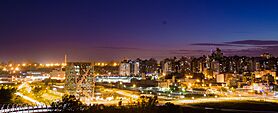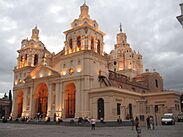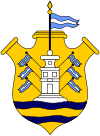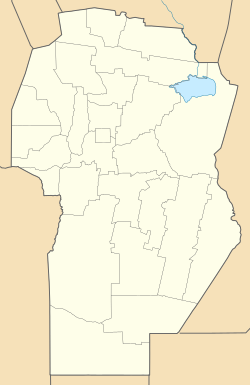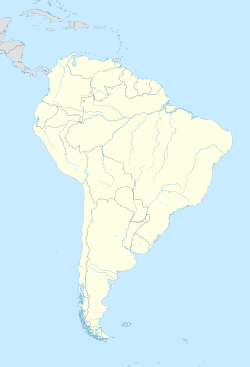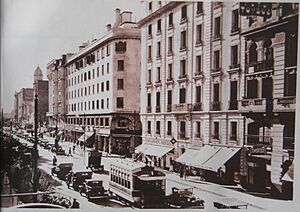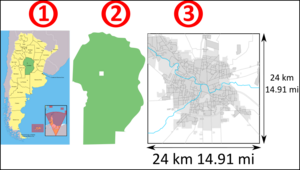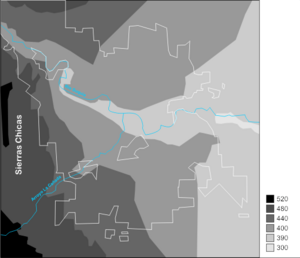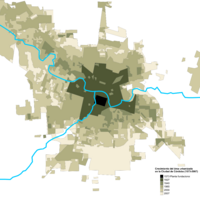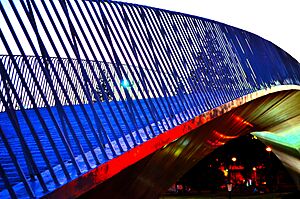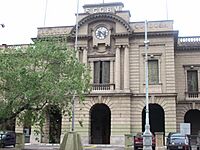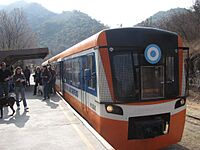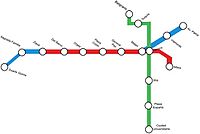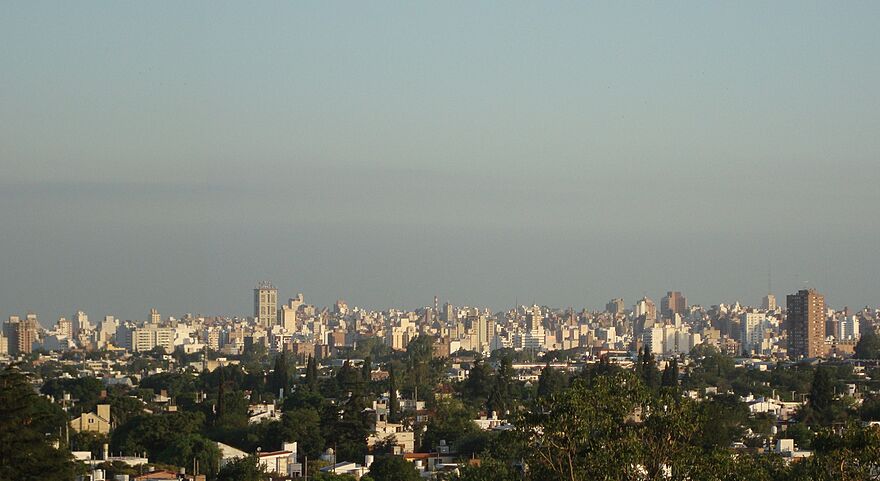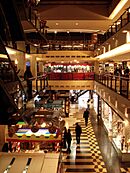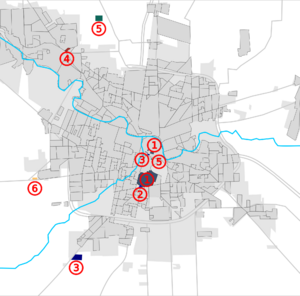Córdoba, Argentina facts for kids
Quick facts for kids
Cordoba
|
|||
|---|---|---|---|
|
City
|
|||
| Ciudad de Córdoba | |||
|
Skyline of Córdoba from Nueva Córdoba
Ferreyra Palace
National University of Cordoba
Capuchin Church
Teatro del Libertador
Mario Alberto Kempes Stadium
|
|||
|
|||
| Country | |||
| Province | |||
| Department | Capital | ||
| Established | 6 July 1573 | ||
| Founded by | Jerónimo Luis de Cabrera | ||
| Named for | Córdoba, Spain | ||
| Area | |||
| • Land | 576 km2 (222 sq mi) | ||
| Elevation | between 352 and 544 m (between 1,155 and 1,785 ft) | ||
| Population
(2022 census)
|
|||
| • Density | 2,273.5/km2 (5,888.46/sq mi) | ||
| • Urban | 2,106,734 | ||
| • Metro | 2,420,052 | ||
| Demonym(s) | Cordoban, (Spanish: cordobés/a) | ||
| GDP (PPP, constant 2015 values) | |||
| • Year | 2023 | ||
| • Total | $37.7 billion | ||
| • Per capita | $23,400 | ||
| Time zone | UTC−3 (ART) | ||
| Official name: Jesuit Block and Estancias of Córdoba | |||
| Type: | Cultural | ||
| Criteria: | ii, iv | ||
| Designated: | 2000 (24th session) | ||
| Reference #: | 995 | ||
| Region: | Latin America and Caribbean | ||
Córdoba is a big city in central Argentina. It sits near the Sierras Chicas mountains, by the Suquía River. It's about 700 kilometers (435 miles) northwest of Buenos Aires. Córdoba is the capital of Córdoba Province. It is also the second-largest city in Argentina, after Buenos Aires. About 1.6 million people live in its urban area.
Córdoba was started on July 6, 1573, by a Spanish explorer named Jerónimo Luis de Cabrera. He named it after the city of Córdoba in Spain. It was one of the first Spanish cities in what is now Argentina. The National University of Córdoba was founded in 1613 by the Jesuit Order. This makes it the oldest university in Argentina. Because of its old university, Córdoba is sometimes called La Docta, which means "the learned" in Spanish.
The city has many old buildings from the time of Spanish rule. Many of these are Catholic Church buildings. The most famous is the Jesuit Block (Manzana Jesuítica). UNESCO named it a World Heritage Site in 2000. It includes buildings from the 1600s, like the Colegio Nacional de Monserrat and the old university campus. This campus is now a museum of the National University of Córdoba. This university has been the second-largest in Argentina for a long time. Córdoba is also known for important student movements, like the University Revolution in 1918.
Contents
History of Córdoba
How Córdoba Began
In 1570, a Spanish leader named Francisco de Toledo asked Jerónimo Luis de Cabrera to start a new settlement. Cabrera led 48 men to the land of the Comechingones people. They arrived in the area of what is now Córdoba on June 24, 1573. Cabrera named the nearby river San Juan, but it's now called Suquía.
The city was officially founded on July 6, 1573. It was called Córdoba de la Nueva Andalucía. This name likely honored the founder's wife's family, who came from Córdoba, Spain. The first settlement was on the left side of the river.
The native people of the area were the Comechingones. They lived in groups called ayllus. After four years, the settlers moved the city to the other side of the Suquía River in 1577. This was because of attacks from the native people. The new city layout was a grid of 70 blocks. Once moved, the city grew steadily. Its economy became strong due to trade with cities in the north.
The Jesuits Arrive
In 1599, the Jesuits religious group came to Córdoba. They started a special school in 1608. In 1610, they opened the Colegio Maximo. This school became the National University of Córdoba in 1613. It is the fourth-oldest university in the Americas. The Jesuit church in Córdoba is one of the oldest buildings in South America. It includes the Monserrat Secondary School and other buildings.
To support their work, the Jesuits ran five large farms called Reducciones. These farms were in the fertile valleys nearby. Some of these places are now towns like Caroya and Alta Gracia. In 1767, the King of Spain ordered the Jesuits to leave the continent. Other religious groups then took over their schools and farms. The Jesuits returned in 1853, but the university became a national school a year later.
Córdoba in Later Years
In 1776, King Carlos III created the Viceroyalty of the Río de la Plata. Córdoba became an important part of this new area in 1785. It included lands that are now the provinces of Córdoba, La Rioja, and Cuyo. By 1760, about 22,000 people lived in the city.
During the May Revolution in 1810, many important citizens wanted to stay loyal to the King. But others, like Dean Funes, supported the revolution. In 1820, the country became 13 separate provinces. Córdoba became an independent province. Two important leaders from Córdoba during this time were Governor Juan Bautista Bustos and General José María Paz. In 1822, Córdoba had about 11,552 people.
Modern Córdoba
By the late 1800s, Argentina began to industrialize. Many European immigrants came to Córdoba. They helped develop new industries. Most of these immigrants came from Italy and Spain. By the early 1900s, Córdoba had 90,000 people. The city changed a lot with new roads and public spaces. An electric tram system was also installed in 1909.
In 1918, Córdoba was the center of the University Reform movement. Students protested against the old university system. This movement spread to other universities in Argentina and beyond. It led to a more modern and open education system.
Córdoba's industries grew quickly. In 1927, a military aircraft factory opened. After World War II, it became very important. It later became the state-owned company Aeronautical and Mechanical Industries of the State (IAME). This factory was later bought by Lockheed Martin in 1995.
By 1947, Córdoba had almost 400,000 people. Many rural families moved to the city for work. This made Córdoba the second-largest city in Argentina by 1970. The city's economy grew in many areas, including services and manufacturing. Córdoba has played a big role in national politics. It was the site of important protests and changes in government.
Geography of Córdoba
Córdoba is located at 31°25′S 64°11′W / 31.417°S 64.183°W. This is in the southern part of the world, in South America. It is in the center-west of Argentina and Córdoba Province. The city is about 702 kilometers (436 miles) from Buenos Aires.
The city's official boundaries extend about 12 kilometers (7.5 miles) from San Martín Square in all directions. This means the city area is about 24 kilometers (15 miles) wide. The total area of the city is 562 square kilometers (217 square miles).
Land and Rivers
Córdoba is on a flat plain called the Humid Pampa. It is just east of the Córdoba Hills, which are about 550 meters (1,800 feet) high. The city sits on both sides of the Suquía River. This river flows into the San Roque reservoir. From there, the Primero River goes east into the plains around Córdoba.
Inside the city, a stream called La Cañada joins the Primero River near the city center. A small island called Isla de los Patos (Ducks Island) is a few kilometers east. It was home to ducks and swans. The river eventually flows into a large salt lake called Mar Chiquita. The river is about 200 kilometers (124 miles) long.
Climate of Córdoba
Córdoba has a humid subtropical climate. This means it has warm, wet summers and mild, dry winters. Cold winds from Antarctica, called Pampas winds, can make the weather cooler.
There are four clear seasons. Summers are from late November to early March. Days are warm, usually between 28°C (82°F) and 33°C (91°F). Nights are between 15°C (59°F) and 19°C (66°F). Thunderstorms are common. Sometimes it gets very hot, over 38°C (100°F). But cool winds often bring relief.
By late February or early March, nights get cooler. April is much drier and pleasant. May usually brings the first frosts and very dry weather. Winters are from late May to early September. Average highs are 18°C (64°F) and lows are 4°C (39°F). Snow is very rare in the city. The lowest temperature ever recorded in Córdoba was -8.3°C (17.1°F).
Spring is very windy and can change quickly. Temperatures can drop a lot from one day to the next. Droughts are most common in spring. Córdoba gets about 750 millimeters (30 inches) of rain each year. The average yearly temperature is about 18°C (64°F). The city center can be a bit warmer than the outer areas because it's a "heat island."
People of Córdoba
Córdoba is the second-largest city in Argentina by population. It has about 1.3 million people. This is about 40% of all the people in Córdoba Province. The city's population grew a lot from 1914 to 1960. Many people moved here from other parts of Argentina and from other countries.
Who Lives in Córdoba?
The biggest groups of people in Córdoba are those with Italians/Italian and Spaniards/Spanish backgrounds. Many immigrants from other European countries also came in the late 1800s and early 1900s. These included people from Switzerland, Germany, the United Kingdom, and Scandinavia. Other Europeans came from Croatia, Poland, Hungary, and Russia. There are also important communities from Lebanon, Syria, and Armenia.
Most immigrants settled in the city or the larger Córdoba area. Some also started farms in different parts of the city.
Population Growth
Córdoba is always growing. It gets many students from other parts of Argentina and South America. This is mainly because of the National University of Córdoba. The city is expanding, especially towards the southern areas like Alta Gracia and Villa Carlos Paz.
City Layout
The city's land is managed by the local government. About 40% of the land is for urban areas, 21% for industrial areas, and 28% for rural areas. The rest is for other uses like military bases.
Córdoba has many green spaces, like small squares and large parks. The Suquia River also has green areas along its banks. The city has about 1645 hectares (4,065 acres) of green spaces.
The old city center has square blocks. The main neighborhoods and roads spread out from the center like spokes on a wheel. The city has grown mostly to the northwest and southeast, following a main road called National Route 9. A large ring road, 47 kilometers (29 miles) long, goes around the city. It was finished in 2019.
Neighborhoods of Córdoba
Córdoba has an important financial area. It is home to the Bank of Córdoba and other banks. Popular places to visit include San Martín Square, the Jesuit Block (a UNESCO World Heritage Site), and the Genaro Pérez Museum. The main streets are Vélez Sarsfield, Colón, General Paz, Dean Funes Avenue, and 27 April Street. San Martin Square is the very center of the city.
Downtown Córdoba has big shopping malls, like Patio Olmos. This mall used to be old warehouses. Now it has elegant shops and offices. Another important place is the Palacio Ferreyra. This beautiful mansion was built in 1916. It became the Evita Perón Museum of Fine Arts in 2007. It is now a main art gallery.
New Córdoba is a growing neighborhood with many important roads like Yrigoyen and Vélez Sarsfield. Many university students live here. New buildings are being built all the time.
Ciudad Universitaria is a district in the south of the city. It is next to Sarmiento Park, which is the city's biggest park. The Universidad Nacional de Córdoba (UNC) has most of its buildings here. The UNC was the first university in Argentina, started by Jesuits around 1622. It is famous for the "Reforma Universitaria" of 1918. This was a student protest that changed how universities were run. It made education more modern and open. Another important university, the UTN, is also in this area. It teaches engineering. The Córdoba Zoo is also in this district.
About 6 kilometers (3.7 miles) from downtown is Cerro de Las Rosas. This is a wealthy neighborhood known for its schools and shops. Rafael Núñez Avenue is a long road here with restaurants, boutiques, and banks. Many people from this area have moved to gated communities for safety.
Getting Around Córdoba
Córdoba has a public transport system with trains, buses, trolleybuses, and taxis. Long-distance buses can take you to most cities and towns in Argentina.
The city has the third-largest airport in Argentina, Ingeniero Ambrosio L.V. Taravella International Airport.
Buses
Buses are the most popular way to travel in Córdoba Province. Many companies offer services for long distances, short trips, and within the city. You used to pay for urban buses with a card called RedBus.
Trains
Córdoba has train services for daily commuters and for longer trips. These are run by a state-owned company called Trenes Argentinos. From the Mitre railway station, trains go to Villa María. The Tren de las Sierras connects the Alta Córdoba area with Cosquín.
Trains from Retiro station in Buenos Aires come to Córdoba twice a week. The trip takes about 18 hours. Many people choose the train because it costs less, but it's much slower than a bus.
The Tren de las Sierras is a tourist train. It goes through the Valle de Punilla and along the Dique San Roque Lake. It runs twice a day, with extra trips on weekends. It takes about 2 to 3 hours to go from Alta Córdoba Station to Cosquín.
Córdoba has two main train stations. The Córdoba (Mitre) station was built in 1886. The Alta Córdoba station was built in 1891.
Future Metro Plans
In 2007, there were plans to build a subway system in Córdoba. The project was approved in 2008. However, it has been stopped since 2012.
Economy of Córdoba
Since World War II, Córdoba has built many different industries. The biggest industries are car and car parts manufacturing. Companies like Renault and Volkswagen have factories here. CNH Industrial also has a factory. Many other companies make car parts for these factories. In 2017–2018, Nissan and Mercedes-Benz started making their new pickup trucks at the Renault factory.
The areas around Córdoba produce a lot of farm products. Some of these products are processed in the city. The province is also a major producer of farm machinery. The candy company Arcor has its main office in Córdoba.
Córdoba is seen as a technology hub in Argentina. The Argentine spaceport (Centro Espacial Teófilo Tabanera) is in a nearby suburb. Here, satellites are developed and operated for CONAE. The software and electronics industries are growing fast. They are now exporting their products. Big companies like Motorola, Intel, and Electronic Data Systems have offices here.
The city also has a strong service economy. This includes retail, professional services, and financial services. It has become a place where new businesses (start-ups) are created. This is partly because many people with technology skills live here.
Sports in Córdoba
Association football (soccer) is the most popular sport in Córdoba. Several local teams play in different leagues. The city has three teams in Argentina's top league: Talleres, Belgrano, and Instituto. The Estadio Mario Alberto Kempes stadium hosted 8 matches during the 1978 FIFA World Cup.
Basketball is the second most popular sport. Asociación Deportiva Atenas is a very popular and successful club. They have won the National League (LNB) seven times. Córdoba was a host city for the Basketball World Cup in 1967 and 1990.
Córdoba also hosted the 2002 FIVB Men's Volleyball World Championship and the UCI BMX World Championships in 2000.
Rugby union is also very popular in Córdoba. There are almost 20 rugby teams. Some of the well-known teams are Tala Rugby Club and Córdoba Athletic Club. Many great rugby players from Argentina and Italy started their careers in Córdoba.
In tennis, the Córdoba Open tournament has been held at the "Polo Deportivo Kempes" since 2019. Famous golf players like Ángel "Pato" Cabrera and Eduardo "Gato" Romero started playing in Córdoba. Tennis player David Nalbandian also began his career here.
The Argentine stage of the World Rally Championship has been held near Córdoba since 1984. Car racing events also take place at Autódromo Oscar Cabalén.
Education in Córdoba
Córdoba has been a major center for education in Argentina for a long time. It has 6 universities and many other colleges. Students from all over Argentina and nearby countries come to study here. This gives the city a special feeling.
The National University of Córdoba was founded in 1613. It is the 4th oldest university in the Americas and the first in Argentina. It has about 105,000 students. It offers many different subjects, from science to arts.
The Córdoba Regional Faculty is part of the National Technological University. It offers degrees in different types of engineering.
The Catholic University of Córdoba is the oldest private university in Córdoba. It has almost 10,000 students.
The Aeronautic University Institute is run by the Argentine Air Force. It offers degrees in aeronautical, telecommunications, and electronic engineering.
The Instituto Tecnológico Córdoba was created by the six universities in the city. Its goal is to help technological development in the area.
Other private universities in the city include Universidad Siglo 21 and Universidad Blas Pascal. The Air Force Academy is also located near the city.
Culture in Córdoba
Literature and Art
Córdoba has a rich history of writers. Famous authors like Leopoldo Lugones and Marcos Aguinis came from here. The city has several well-known museums. The Caraffa Fine Arts Museum was founded in 1916. The Evita Fine Arts Museum opened in 2007.
The Paseo del Buen Pastor is a cultural center that opened in 2007. It has an art museum and shops. These shops sell products from local artists, like wine, cheese, and leather goods.
Music Scene
The special music of Córdoba is called cuarteto. You can hear it at many parties and pubs. Some popular cuarteto singers are Carlos La Mona Jiménez and Rodrigo. The places where they perform are called bailes (dances).
Other popular music styles for young people are electronic music and reggaeton. These are often played at boliches, which is what night clubs are called in Argentina. Córdoba is sometimes called "the nightlife city" because it has so many clubs.
Córdoba also has a rich music scene for classical, jazz, rock, and pop. The Teatro Libertador San Martín often hosts concerts, operas, and plays.
Famous Buildings
Córdoba has many old buildings from the time it was a Spanish colony. In the center, near the Plaza San Martín square, is the Jesuit Cathedral. Its altar is made of stone and silver. The roof is painted with Bible scenes. Another important old building is the Cabildo (the old government house). It is next to the church. The Jesuit Block, Monserrat School, the University, and the Jesuit church are also in Córdoba.
In Nueva Córdoba, you can find the "Iglesia del Sagrado Corazón de Jesús," also known as "Los Cappuchinos." This church is a great example of Neo Gothic style.
Fun Festivals
The first festival of the year is Carnival in February. Kids have fun throwing water balloons at each other in the street.
In the middle of the year, on July 20, Friends Day is celebrated. Teenagers often meet at Parque de las Naciones or Parque Sarmiento. They spend the afternoon there and then go dancing at night.
The last festival is Spring Day, on September 21. This is also Students' Day. Many people go to the park or visit the nearby city of Villa Carlos Paz. They can enjoy concerts, dancing, and visiting the river.
Notable People from Córdoba
Córdoba is the birthplace of many famous people, including:
- Ossie Ardiles (b. 1952), a football manager and former player who won the 1978 FIFA World Cup.
- Ángel Cabrera (b. 1969), a golf player.
- Paulo Dybala (b. 1993), a football player.
- Gregorio Funes (1749–1829), a clergyman and author.
- Luis Juez (b. 1963), a politician.
- Paulo Londra (b. 1998), a rapper.
- David Nalbandian (b. 1982), a tennis player.
- Fabricio Oberto (b. 1975), a basketball player.
- Eduardo "Gato" Romero (b. 1954), a golf player.
Images for kids
See also
 In Spanish: Córdoba (Argentina) para niños
In Spanish: Córdoba (Argentina) para niños


